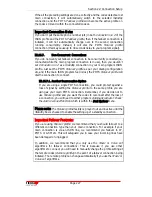
Section 22: Connection Setup
T
ieline
Page 222
T E C H N O L O G Y
22.16.2.
Which Solution is Best for My Situation
Determining what you want the codec to do and how to program it is easy -
once you understand how a codec manages connections.
In simple terms, if you simply want the codec to redial a connection if it is
interrupted for some reason, it is best to either set
Automatic Redial
or
Auto
reconnect
within the codec. The basic difference between these two
connections is that you can set the amount of redials using
Automatic Redial
,
whereas
Auto reconnect
will continue to redial until a connection is made. In
addition, with
Automatic Redial
you will need to initiate the call by dialing
manually when the connection is lost. It will then automatically try to redial.
With
Auto reconnect
, the codec will automatically try to redial when a
connection is lost.
If you purchase the failover option from
T
ieline
you can also program more
complex failover reconnections into your codec. Failover can be divided into
two parts. First, there is simple failover which utilises codec user functions to
reconnect. Second, there is a more complex failover setup which allows you
to use
Standby
connections and which gives you the ability to program
profiles into the codec if a connection is lost.
22.16.3.
Enabling a Codec for Failover Operation
Once you have purchased the option from
T
ieline
,
to use failover functions
you will need to input a 12 digit code into your codec. To access the
Failover
Enable
menu on the codec, which allows you to enable failover, please do the
following:
Press
SOFTKEY 4
on the codec to access the
Menu
submenus;
Scroll using the
MS
to
Configuration
and press the
MS
to select it;
Then scroll to
Advanced
with the
MS
and select this option;
Scroll to
Failover Enable
and select this option;
Select
Enable
and then enter the code that you have been given by
T
ieline
.
Your codec will now be programmable for failover configurations.
22.16.4.
Programming Simple Failover via a User Function
Simple failover can be programmed by simply enabling failover in the codec
via the
Failover Enable
menu in the codec and then programming a User
Function to initiate the failover. The benefit of using simple failover is that
you won’t need to create a new profile to program as the
Failover profile
.
You can simply use the same manual default profile or other profile you have
created, and that you are using for your main connection. (This can’t be done
if you are using a
Standby
connection running concurrently. You will need to
program a more complex failover connection).
With the new
T
ieline
Phonebook Editor
it is also possible to change the
profile by dialing a new phone book entry that has a different profile
associated with it.






























